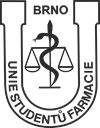STUDENTSKÁ VĚDECKÁ KONFERENCE
MAGISTERŠTÍ STUDENTI
25. 4. 2023
9:00 - 14:15, Pavilon farmacie I
Program chemické sekce
Pavilon farmacie I
-
9:00 - 9:05
Zahájení konference
-
9:05 - 9:15
Prezentace sponzora konference: VIRA CHEMimp
-
10:15 - 10:30
Synthesis and Evaluation of Cinnamic Acid Carboxamides
Jaroslava Jamrichová 1, Veronika Kadlecová 1, Juliana Lavičková 1
1 Department of Chemical Drugs, Faculty of Pharmacy, Masaryk University
e-mail: gonect(@)pharm.muni.cz
Key words: synthesis, cinnamic acid carboxamide
Nature is an inspiring and rich source of compounds with biological activity. Many plant secondary metabolites have been used as templates for the development of synthetic drugs. One such example is cinnamic acid and its derivatives, such as coumaric, caffeic, ferulic or sinapic acid, which are present in many plant species. Cinnamic acid has been the template for many novel synthetic compounds that have shown interesting in vitro antimicrobial, antiproliferative, antiparasitic, neurological, antioxidant and anti-inflammatory effects. [1]
The aim of the work was synthesis and structural characterization of a complete series of 54 substituted N-phenyl 3,4-dichlorocinnamic acid carboxamides. The derivatives differed by substitution on the phenyl ring with both electron-donating and electron-withdrawing substituents, their combination and various positional arrangements. Several analogic derivatives tested earlier [2] showed excellent antimicrobial and antimycobacterial activity with low human cell cytotoxicity.
The compounds were prepared by a microwave-assisted one-step synthesis. 3,4-dichlorocinnamic acid reacted with corresponding substituted aniline in the presence of phosphorous trichloride in chlorobenzene. [2]

[1] Ruwizhi, N., Aderibigbe, B. A. Cinnamic acid derivative and their biological efficacy. Int. J. Mol. Sci. 2020, 21, 5712
[2] Strhársky, T., Pindjaková, D., Kos, J. et al. Study of Biological Activities and ADMET-Related Properties of Novel Chlorinated N- arylcinnamamides. Int. J. Mol. Sci. 2022, 23, 3159
Acknowledgement: This research was supported by project MUNI/A/1210/2022
Supervisor: PharmDr. Tomáš Goněc, Ph.D.; PharmDr. Tomáš Strhársky
-
10:30 - 10:45
Synthesis of Potential Metalloenzyme Inhibitors
Julie Řeháková 1, Kateřina Urbanová 1
1 Department of chemical drugs, Faculty of Pharmacy, Masaryk University
e-mail: 483977(@)mail.muni.cz, 507434(@)mail.muni.cz
Key Words: potential inhibitors, metalloenzymes, HDAC inhibitors, acrylamide synthesis
The main aim of this experimental study was to prepare new compounds, which could be used as metalloenzyme inhibitors. About one third of all proteins are metalloproteins, which have extended spectrum of functions in vivo, including regulation of blood pH, modulation of DNA transcription etc. Metalloproteins contain a metal ion as a cofactor. Dysfunction of their regulation may have effect on progression of many diseases, including cancer, heart disease, and HIV/AIDS. For that reason, inhibition of metalloenzymes is an attractive target of their treatment [1;2].
Experimental work contained four steps of the synthesis. It was based on the reaction of methyl p-hydroxycinnamate with several substituted 2-chloro-N-phenylacetamides prepared from corresponding anilines and 2-chloroacetyl chloride in the basic condition. Methyl ester was hydrolyzed to acid and, in the last step, substituted acrylamide was synthesized.
The purity and structures of prepared compounds were analyzed by TLC, NMR and HPLC.

References:
[1] HOPPERT, Michael. Metalloenzymes. In: REITNER, Joachim a Volker THIEL, ed. Encyclopedia of Geobiology [online]. Dordrecht: Springer, 2011, s. 558-563 [cit. 2023-03-28]. Encyclopedia of Earth Sciences Series. ISBN 978-1-4020-9212-1. Dostupné z: https://link.springer.com/referenceworkentry/10.1007/978-1-4020-9212-1_134
[2] DAY, Joshua A. a Seth M. COHEN. Investigating the Selectivity of Metalloenzyme Inhibitors. Journal of Medicinal Chemistry [online]. 2013, 56(20), 7997–8007 [cit. 2023-03-28]. Dostupné z: https://doi.org/10.1021/jm401053m
Supervisor: Mgr. Hana Pížová, PhD.
-
10:45 - 11:00
Protein Recognition Using Metal-Based Nanoparticles
Lívia Rigasová 1
1 Department of Chemistry, Faculty of Science, Masaryk University
2 Department of Chemistry and Biochemistry, Faculty of AgriSciences, Mendel Universitye-mail: 499521(@)mail.muni.cz
Keywords: gold nanoparticles, silver nanoparticles, protein recognition, multiplex
Immunochemical methods, widely used in biochemistry or clinical applications, use the labeled antibody’s ability to recognize and bind the antigen. Commonly used methods are often limited to analyzing no more than three antigens. Labeling with nanoparticles combines the advantages of nanoparticles and the selective ability of antibodies to recognize antigens.1 Laser ablation with inductively coupled plasma mass spectrometry, LA ICP-MS, is an elemental imaging method for nanoparticle conjugates with detection limits comparable to fluorescence spectroscopy. The advantage is the possibility of simultaneously determining a larger number of inorganic elements within one analysis. The method of detecting several antigens and antibodies with different metal NP in biological samples is called multiplex.
The work aimed to use gold and silver nanoparticle labeled antibodies for antigen imaging and to verify the functionality of LA ICP-MS for multiplex analysis. The functionality of the conjugates was tested by immunoblotting using the dot-blot technique. Visualization was performed using laser ablation line scans with ICP-MS.
The experimental part shows that the binding between the antibody and the metal nanoparticle does not impair its ability to recognize and bind the antigen. A direct relationship between the measured signal’s intensity and the nanoparticle’s size was found. At the same time, it was found that bulkier 60 nm nanoparticles are more susceptible to forming non-specific bonds than 10 nm nanoparticles. The method used in this work has the potential to be applied in the determination of a wider amount not only of model antigens but also of protein extracts of real samples within one analysis due to the use of broader metal nanoparticle range.
References:
- WU, H., B., Alan. Immunochemical Techniques; Clinical chemistry: Principles, Techniques and Correlations. In Clinical chemistry: Principles, Techniques and Correlations, 2018; Vol. 8, pp 164-165.
Acknowledgments: This study was supported by project GACR: GA20-02203S.
Supervisors: doc. Mgr. Tomáš Vaculovič, Ph.D.; Mgr. Marcela Vlčnovská
-
11:00 - 11:15
Nanoparticles as a New Tool for The Diagnosis and Treatment of Ischemic Stroke
Jan Biskupič 1, Marcela Vlčnovská 3, Jana Hložková 4, Petr Scheer 4, Tereza Padrtová 2, Radka Opatřilová 2, Viktor Kanický 1, Tomáš Vaculovič 1 and Michaela Kuchynka 1,2
1 Department of Chemistry, Faculty of Science, Masaryk University, Kotlářská 2, 611 37 Brno, Czech Republic
2Department of Chemical Drugs, Masaryk University in Brno, Palackého třída 1946/1, 612 00 Brno;
3 Department of Pathological Physiology, Faculty of Medicine, Masaryk University, Kamenice 5, 625 00, Brno, Czech Republic
4 Department of Pharmacology and Toxicology, Masaryk University, Palackého třída 1946/1, 612 00 Brnoe-mail: 495294(@)mail.muni.cz
Key words: Ischemic stroke, polyiodined nanoparticles, LA-ICP-MS
Ischemic stroke (IS) was identified as the second most common cause of death worldwide in 2019, according to a survey [1]. A large percentage of patients remain with permanent consequences that can persist even fifteen years after the event [2]. This is also associated with economic impacts on healthcare and supportive services, which amounted to approximately 60 billion euros in the EU in 2017 [3]. The key to success is time. IS can already be precisely diagnosed nowadays. However, in each specific situation, there is a problem with detecting the onset of stroke, which is crucial for choosing the appropriate treatment and thus saving lives. Today’s commonly used medical scanning devices can only visualize clots with high erythrocyte content. Other forms of thrombi become very difficult to recognize [4]. Polyiodinated biodegradable nanoparticles (IoNPs) have the potential to solve this problem. The current preclinical phase of our project is focused on researching the pharmacokinetics of these potential IoNPs theranostics in the body. A unique method LA‑ICP-MS is used to determine the IoNPs and biogenic elements distribution (Fig. 1).

References
[1] Global Burdens of Disease – GBD Results. https://vizhub.healthdata.org/gbd-results/. (accessed 9/1/2023)
[2] Gallacher, K. I. et al. Stroke, multimorbidity and polypharmacy in a nationally representative sample of 1,424,378 patients in Scotland: Implications for treatment burden. BMC Med 12, 1–9 (2014).
[3] Luengo-Fernandez, R., Violato, M., Candio, P. & Leal, J. Economic burden of stroke across Europe: A population-based cost analysis. Eur Stroke J 5, 17–25 (2020).
[4] Kim, J., Park, J. E., Nahrendorf, M. & Kim, D. E. Direct Thrombus Imaging in Stroke. J Stroke 18, 286–296 (2016).Acknowledgement: The study was supported by Grant Agency of Masaryk University – Excellent diploma thesis, MUNI/C/0002/2023.
Supervisor: Mgr. Michaela Kuchynka, Ph.D.
-
11:15 - 11:30
Phytochemical Profilation of Extracts from Different Parts of Arctium Species
Jitka Křížová 1, Milan Malaník 1
1 Department of Natural Drugs, Faculty of Pharmacy, Masaryk University
e-mail: jituninkakriz(@)seznam.cz
Key Words: Arctium species, antidiabetic activity, HPLC, arctiin and arctigenin
Introduction: Plants of the genus Arctium grow widely all over Europe, in Asia and are also spread to America. In Asia, the leaves and roots have been eaten as a vegetable for centuries. In folk medicine, Arctium species are used internally as a diuretic, carminative, and for anti-inflammatory and antidiabetic purposes. The roots are traditionally recommended as an aphrodisiac. Externally, Arctium species are used in folk medicine to treat wounds, ulcers, bruises and hair loss.
Aim: The goal was to develop research dealing with the antidiabetic activity of Arctium species. Furthermore, the task was to phytochemically profile extracts from different parts and from different species. Extraction of Arctium species was carried out in ethanol and substances were detected by using high-performance liquid chromatography (HPLC-DAD and HPLC-ELSD). Further, the amount of arctiin and arctigenin in the fruits of Arctium species was determined.
Results: The roots in the first year of the plant's life contain several different substances, in the case of A. tomentosum it will probably be chlorogenic acid and its derivatives. All species in the second year of the plant's life contain at most one substance in their roots, probably a derivative of chlorogenic acid. Not many substances were detected in the leaves, thanks to which it was concluded that the extracts from the leaves are not very suitable for the next stage of identification of secondary metabolites. Arctiin and arctigenin were detected in fruit extracts. When determining the content, it was found that arctiin occurs in the fruits more than arctigenin.
Conclusion: According to the available literature, Arctium species have several components responsible for antidiabetic activity. This work investigated the presence of these substances in individual species and parts of the genus Arctium to clarify which species or parts of these plants are the best for further study. Subsequent studies of the antidiabetic properties of Arctium species could help in the therapy of DM and the prevention of diabetic complications.
Acknowledgement: This research was supported by the project MUNI/A/1243/2021.
Supervisor: PharmDr. Milan Malaník, Ph.D.
-
11:30 - 11:45
Přestávka
-
11:45 - 12:00
Phytochemical Analysis of Selected Parts of Ficus Species I
Terézia Jedináková 1
1 Department of Natural Drugs, Faculty of Pharmacy, Masaryk University
e-mail: 507387(@)mail.muni.cz
Key words: Ficus cyathistipula, prenylated flavonoids, chromatographic methods, isolation, identification
This study is focused on the isolation and identification of prenylated flavonoids from selected parts of Ficus species (F. cyathistipula, F. lyrata, F. pumila, F. triangularis) by using different chromatographic methods.
The experiment deals with the analysis of total extracts of selected figs. They were analyzed by using HPLC-DAD method. The root extract of F. cyathistipula was preferred as a potential source of prenylated flavonoids. This extract was subjected to liquid-liquid extraction, from which chloroform fraction was selected as a rich source of expected substances. Subsequently, it was subjected to column chromatography and semipreparative HPLC.
Obtain substances were identified by using methods HPLC-DAD, IR, and NMR. The result was the isolation of pure substances that were identified as ficusin A, ficusin B, and four prenylated isoflavones, which were isolated from plant material for the first time.


Acknowledgement: The study was supported by the project MUNI/A/1245/2021.
Supervisor: PharmDr. Milan Malaník, Ph.D.
-
12:00 - 12:15
Isolation of Compounds from Maclura pomifera Bark
Ivana Machalová 1
1 Department of Natural Drugs, Faculty of Pharmacy, Masaryk University,
e-mail: 484553(@)muni.cz
Key words: Maclura pomifera, xanthones, chromatographic methods
Introduction: Maclura pomifera (Moraceae) is a dioecious tree native to North America. Its root bark is known for being a source of biologically active xanthone derivatives. The occurrence of xanthones in the stem bark has been described only in related species. Xanthones are secondary metabolites specific for several plant families exhibiting various biological activities.
Aim: This work deals with literature research focused on xanthones, their biological activity and the structure-activity relationship. Furthermore, it deals with the isolation and identification of selected compounds, especially xanthones, from M. pomifera stem bark.
Methods: The isolation of compounds was performed by using chromatographic methods. The fractions were obtained from hexane and chloroform portions of ethanolic extract by column chromatography. Another source for the isolation was the pink precipitate from water/ethyl acetate interphase which was separated by preparative HPLC. The nature and purity of the fractions and isolated compounds were subsequently analysed by HPLC or TLC. The selected substances were identified by NMR, MS and UV/Vis.
Results: We isolated three xanthones and probably a compound of terpene origin. Isolated xanthones were identified as 1,3,5,6-tetrahydroxyxanthone-4-glucoside (Fig. 1) – a new compound, 1,3,5,6-tetrahydroxyxanthone (Fig. 2) – isolated for the first time from M. pomifera and osajaxanthone – previously isolated from M. pomifera root bark (Fig. 3).



Supervisor: PharmDr. Margita Dvorská, Ph.D.
-
12:15 - 12:30
Isolation of Plant Secondary Metabolites Using Different Chromatographic Methods
Peter Fedák 1
1 Department of Natural Drugs, Faculty of Pharmacy, Masaryk University,
e-mail: 507369(@)mail.muni.cz
Keywords: chromatographic methods, Paulownia tomentosa, prenylated flavonoids, isolation, Alzheimer’s disease
The presented thesis deals with the isolation of secondary metabolites from the plant Paulownia tomentosa Steud. using different chromatographic methods. This fast-growing tree has been a part of traditional Chinese medicine for several centuries in connection with the treatment of many diseases. Among its secondary metabolites we find a variety of different structures such as flavonoids, terpenes, phenolic glycosides, lignans, phenolic acids, etc.
In recent years, this plant has been the subject of great interest, mainly due to its high content of prenylated flavonoids with promising biological effects.In this work, the effects of prenylated flavonoids from different plant species on the inhibition of cholinesterases have been described in more detail, which could thus expand the treatment options for Alzheimer's disease. In an experimental part, the isolation of substances from the ethanolic extract of Paulownia fruits is described. From the fraction PT21/CH/A35-39+B31-39, which was obtained by column chromatography from the chloroform fraction of the extract,
2 pure compounds were isolated by chromatographic methods. Compounds were identified as tomentone II and mimulone.Tomentone II and its inhibitory activity on cholinesterases has not yet been described in any scientific study and could thus be the subject of further scientific investigation.


Supervisor: PharmDr. Lenka Molčanová, Ph.D
-
12:30 - 13:15
Přestávka
-
13:15 - 14:00
Zasedání odborných hodnoticích komisí
-
14:00 - 14:15
Vyhlášení výsledků
-
od 14:15
Raut













